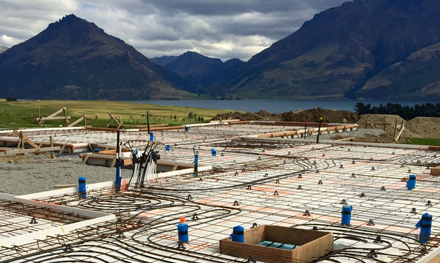Concrete Insulation Demystified: Tips for a Warmer, Energy-Efficient Home

As the pursuit of energy efficiency and sustainability gains momentum in home construction, one often overlooked aspect is concrete insulation.
Concrete, known for its durability and structural strength, can contribute significantly to a home’s insulation properties when approached thoughtfully.
In this article, we will demystify concrete insulation, exploring tips and strategies to create a warmer, more energy-efficient home.
I. Understanding Concrete as a Thermal Mass
Concrete, by its nature, has high thermal mass properties, meaning it can absorb, store, and release heat over time.
While this characteristic makes it an excellent material for maintaining a stable indoor temperature, it also poses challenges when it comes to insulation.
Uninsulated concrete can conduct heat, leading to energy loss and discomfort in varying weather conditions.
Insulated concrete floors address these challenges by incorporating additional materials that enhance thermal resistance. This not only mitigates heat conduction but also contributes to energy efficiency and improved comfort within buildings.
II. Types of Concrete Insulation
1.Exterior Insulation:
Insulating the exterior of a concrete structure involves adding insulation material, such as rigid foam boards, to the outer surface before applying the final finish.
This method creates a thermal barrier, preventing heat transfer through the concrete walls and significantly improving energy efficiency.
2. Interior Insulation:
Alternatively, insulating the interior of a concrete structure involves adding insulation materials directly to the inside walls.
This method is suitable for existing structures or those where altering the exterior is not feasible. Interior insulation can include materials like spray foam, fiberglass batts, or rigid foam boards.
III. Tips for Effective Concrete Insulation
1. Choose the Right Insulation Material:
The choice of insulation material plays a crucial role in the effectiveness of concrete insulation.
Common options include expanded polystyrene (EPS), extruded polystyrene (XPS), and polyurethane foam.
Each material has its unique properties, including thermal resistance and moisture resistance, so selecting the one that aligns with your specific needs is essential.
2. Address Thermal Bridges:
Thermal bridges, areas that allow heat to transfer more easily through the structure, can compromise insulation efforts.
In concrete structures, these bridges often occur at joints, corners, or areas with metal components. Ensuring proper insulation coverage and using thermal break materials can help mitigate these thermal bridges.
3. Consider Insulated Concrete Forms (ICFs):
ICFs are prefabricated forms made of insulating material that fit together like building blocks to create walls.
These forms are then filled with concrete, providing both structural support and insulation.
ICFs offer a comprehensive solution for energy-efficient construction, combining the benefits of concrete’s thermal mass with integrated insulation.
4. Ensure Proper Installation:
Regardless of the insulation material chosen, proper installation is crucial for optimal performance.
Gaps, voids, or poorly installed insulation can compromise the overall effectiveness of the insulation layer. Hiring experienced professionals familiar with the specific requirements of concrete insulation is recommended.
IV. Benefits of Concrete Insulation
1. Improved Energy Efficiency:
The primary benefit of concrete insulation is improved energy efficiency. By reducing heat transfer through the walls, insulated concrete structures require less energy for heating and cooling, leading to lower utility bills and a reduced carbon footprint.
2. Enhanced Comfort:
Insulated concrete contributes to a more comfortable indoor environment by minimizing temperature fluctuations. The thermal mass of concrete, combined with effective insulation, creates a more stable and pleasant living space.
3. Moisture Control:
Insulation also acts as a moisture barrier, preventing condensation and moisture infiltration. This is particularly crucial in climates with high humidity, reducing the risk of mold and mildew growth and ensuring a healthier indoor environment.
V. Cost Considerations and Return on Investment
1. Initial Investment vs. Long-Term Savings:
While the initial cost of incorporating concrete insulation may be higher than traditional methods, the long-term savings in energy bills can offset these upfront expenses.
Homeowners should view concrete insulation as a strategic investment that pays off over time in terms of comfort and reduced utility costs.
2. Potential Government Incentives:
In some regions, governments offer incentives or rebates for energy-efficient home improvements.
Checking local programs and incentives can provide additional financial support for incorporating concrete insulation into your home.
VI. Innovations in Concrete Insulation
1. Smart Insulation Technologies:
Advancements in smart technologies are extending to insulation materials. Smart insulation, equipped with sensors and responsive capabilities, can adapt to changing environmental conditions, further optimizing energy efficiency and comfort.
2. Sustainable Insulation Materials:
The push towards sustainable construction practices has led to the development of eco-friendly insulation materials. Some options include recycled or bio-based materials that provide insulation without negatively impacting the environment.
Conclusion
Concrete insulation represents a key element in creating homes that are not only structurally robust but also energy-efficient and comfortable. By understanding the dynamics of concrete as a thermal mass and employing effective insulation strategies, homeowners can significantly enhance the performance of their homes.
From choosing the right insulation materials to considering innovative technologies and sustainable practices, the journey to a warmer, energy-efficient home through concrete insulation is both achievable and rewarding. As the construction industry continues to evolve, embracing the potential of concrete insulation becomes not just a choice but a smart and forward-thinking investment in the future of home comfort and sustainability.



